New Chromatography Columns and Accessories for 2015
LCGC North America
Volume 33 Number 4Pages 234-247This is our annual review of new liquid chromatography (LC) columns and accessories introduced at Pittcon and throughout the previous year. This year, Michael Swartz, former author of our "Innovations in HPLC" and "Validation Viewpoint" columns, steps in as a guest columnist to write the review.
This is our annual review of new liquid chromatography (LC) columns and accessories introduced at Pittcon and throughout the previous year. This year, Michael Swartz, former author of our "Innovations in HPLC" and "Validation Viewpoint" columns, steps in as a guest columnist to write the review.
For 32 years, LCGC has published an annual Pittcon review article, written by Ron Majors. These reviews started with Majors's second installment of the "Column Watch" column in May 1983. Each year, Majors summarized the new chromatography columns and sample preparation instruments introduced at the conference, while also explaining the significance of these developments and analyzing the trends. Over the years this article has become the standard reference describing the latest developments in the field, and I'm honored to be the guest author of this year's review.
LCGC has decided to change up a few other things too. For years, Pittcon was the focal point for most, if not all vendor new product introductions. However, in recent years, many vendors have turned to other conferences (for example, the International Symposium on High Performance Liquid Phase Separations and Related Techniques [HPLC], Symposium on the Interface of Regulatory and Analytical Sciences for Biotechnology Health Products [WCBP], American Society for Mass Spectrometry Conference on Mass Spectrometry & Allied Topics [ASMS], Analytica, and others), as well as on-line, website-based, and social media introductions, catering to a more specialized or targeted audience. For this reason, LCGC sent out a survey in early 2015 asking vendors to submit products launched at any time during the past year. So, this review will encompass any liquid (high performance liquid chromatography [HPLC], ultrahigh-pressure liquid chromatography [UHPLC], ion chromatography [IC]) and supercritical fluid chromatography (SFC) columns and related devices introduced since Pittcon 2014, with sample preparation and gas chromatography (GC) new product introductions treated similarly, but separately (1–3). The information presented here may not be exhaustive since it is based on the survey, and not all vendors queried responded. However, the vendors that did respond are listed in Table I. Readers are encouraged to consult with the vendors for more-detailed information beyond that included here.

This installment is divided roughly according to column and application types: traditional reversed-phase, core–shell, hydrophilic-interaction chromatography (HILIC), ion-exchange, SFC, biomolecule, and ion chromatography applications, and related devices. The goal of this column installment is to successfully summarize the bulk of the vendor introductions over the last year, and present trends that stimulate ideas for more research from the application niches represented.
Reversed-Phase Chromatography
Several new columns and guard columns were introduced that can be categorized as reversed phase, whether they are totally porous or superficially porous, or alternative reversed-phase (for example, pentafluorophenyl or alkylamide) particle columns, as summarized in Table II. Many, if not all, of these columns were introduced as "families," or columns available over a wide particle size range (1.7 to 5 or 10 µm) to scale or transfer separations from UHPLC to HPLC, to semipreparative or preparative HPLC, and a variety of column dimensions.
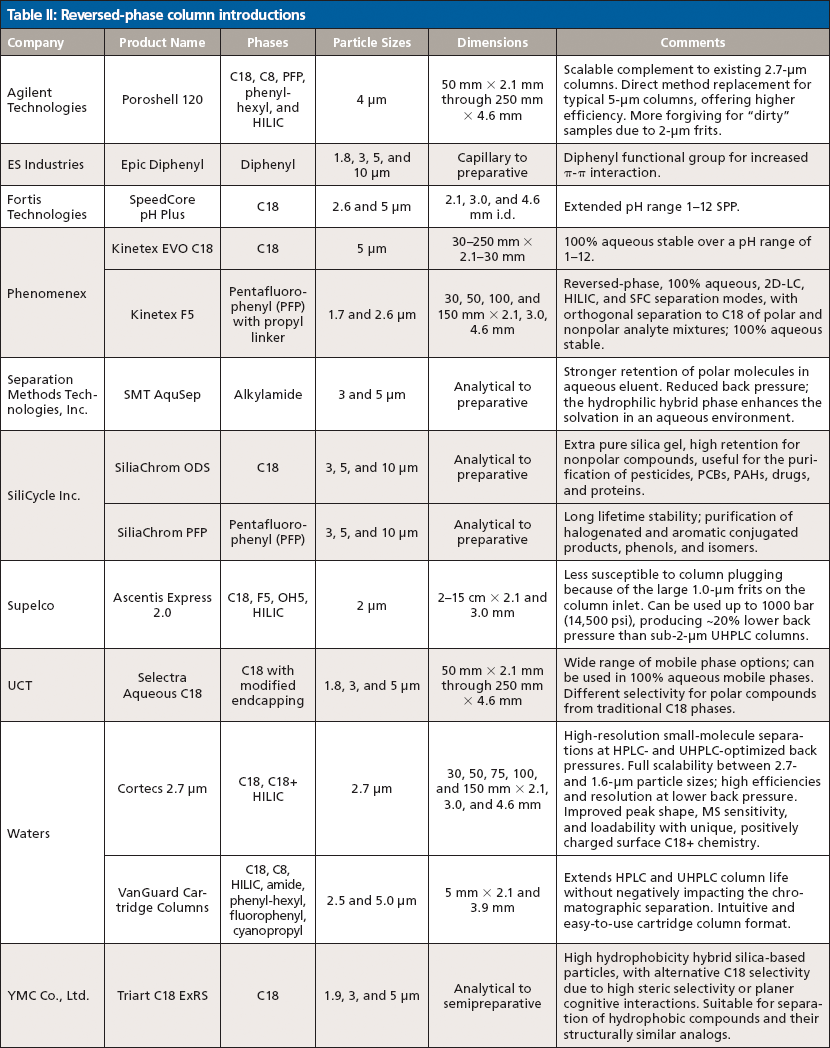
YMC, UCT, and SiliCycle all introduced families of C18 particles of varying hydrophobicities. YMC's Triart C18 ExRS and SiliCycle's SiliaChrom ODS, with a 25% and 15% carbon load, respectively, are aimed at more-polar, hydrophobic compound applications. UCT's Selectra Aqueous C18, with modified endcapping and a 10% carbon load, is said to provide different selectivity versus traditional C18 particles for polar compounds.
SiliCycle (SiliaChrom PFP) and Phenomenex (Kinetex F5) both introduced alternative-selectivity reversed-phase columns based on a penta-fluorophenyl (PFP) functional group. The PFP functional group, because of the highly electronegative fluorine atoms on the periphery of the phenyl ring, can provide unique selectivity versus C18 columns for aromatic and halogenated compounds. Alternative-selectivity reversed-phase column introductions also included Separation Methods Technology's SMT AquSep (alkylamide functional group), and ES Industries' Epic Diphenyl. The SMT AquSep column, by virtue of having both hydrophobic and hydrophilic spacer ligands, is described as having better retention of polar analytes, and extremely acidic or basic compounds. ES Industries' Epic Diphenyl column takes advantage of improved π-π interactions to provide better selectivity for aromatic compounds.
Solid core–shell or superficially porous particles (SPPs) continued to generate interest during the past year, with both new introductions and product-line extensions. SPPs are attractive because they can provide efficiencies equivalent to a smaller particle, at a much lower back pressure. Consequently, existing HPLC systems can be used, although a case can still be made that lower dispersion systems (such as UHPLC systems), capable of operating at higher back pressures, will result in separations with even higher efficiencies. Waters introduced the Cortecs family of columns in mid-2014. Cortecs columns are available as both 1.6- and 2.7-µm SPPs, in a variety of column dimensions, and in three stationary phases: C18, HILIC (unbonded), and a charged C18+ chemistry. The charged C18+ chemistry features a positively charged surface modification for improved peak shape of basic compounds when they are analyzed using acidic, low-ionic-strength mobile phases such as formic acid. Supelco expanded upon its SPP product line with the introduction of the Ascentis Express 2.0 family of columns. These columns are another good choice for improving the performance of traditional HPLC systems. The Supelco 2.0 µm SPP is available in C18, HILIC, OH5 (pentahydroxy for the fast analysis of polar compounds), and an F5 (PFP) stationary phase, and in a variety of column dimensions. Both Fortis and Phenomenex also introduced columns in the SPP category, both aimed at extending the available pH range. Fortis introduced the SpeedCore pH Plus column, in both 2.6- and 5.0-µm particle sizes, and 2.1-, 3.0-, and 4.6-mm internal diameters. Phenomenex introduced Kinetex EVO C18, a 5.0-µm SPP available in analytical (30 mm × 2.1 mm) to preparative (250 mm × 30 mm) dimensions. Both the Fortis and the Phenomenex SPPs can operate over a pH range of 1–12, providing a valuable tool in method development selectivity screening. Agilent Technologies expanded on their SPP product line with the new Poroshell 120 4-µm particle size columns, an addition to the existing 2.7-µm version. The new Poroshell 120 columns are a family of five chemistries consisting of C18, C8, PFP, phenyl-hexyl, and HILIC, and are available in a variety of dimensions with internal diameters ranging from 2.1 to 4.6 mm and lengths ranging from 50 to 250 mm.
The often complex sample matrices encountered in pharmaceutical, natural product, environmental, and industrial chemical analysis can lead to short column lifetimes and degrade chromatographic performance. Guard columns are often useful for removing particulate and chemical contamination that may be present in the mobile-phase or samples, without compromising chromatographic performance. For this reason, Waters introduced the general purpose, easy-to-use VanGuard family of cartridge columns, designed to protect HPLC and UHPLC analytical columns. They are available in 2.1- and 3.9-mm internal diameters, 2.5- and 5.0-µm particle sizes, and a variety of stationary phases (C18, C8, HILIC, amide, phenyl-hexyl, PFP, and cyanopropyl).
Ion Chromatography
In ion chromatography (IC), the stationary phase surface contains ionic functional groups that interact with analyte ions of opposite charge. IC is further subdivided into anion- and cation-exchange chromatography. Three companies provided information about new products introduced for IC applications: MicroSolv Technology Corporation, SiliCycle Inc., and Thermo Fisher Scientific, split evenly between anion and cation exchangers (Table III).

In the anion-exchange category, Thermo Fisher Scientific introduced two new products, the IonPac AS27 and the IonPac AS22-Fast-4µm anion-exchange columns. The IonPac AS27 column is a polymeric 55% divinylbenzene–ethylvinylbenzene cross-linked phase, with an alkanol quaternary ammonium ion functional group, on a 6.5-µm particle. The IonPac AS27 column is aimed at the trace-level analysis of bromate in the presence of parts-per-million levels of ethylenediamine (EDA) in drinking water samples. The IonPac AS22-Fast-4µm anion-exchange column is based on the same chemistry as the AS27, but on a smaller, 4-µm particle, and when combined with the company's EGC-500 K2CO3 cartridge provides electrolytic generation of carbonate and carbonate–bicarbonate mixtures at pressures commonly required for columns based on 4-µm particles, up to 5000 psi. Figure 1 shows an example of the separation of seven common anions on the IonPac AS22-Fast-4µm column, demonstrating good repeatability.

Figure 1: Separation of seven common anions. Column: 150 mm × 4 mm IonPac AS22-Fast-4 µm (Thermo Fisher Scientific); fluent: 4.5 mM potassium carbonate–1.4 mM potassium bicarbonate (EG); flow rate: 1.5 mL/min; temperature: 30 °C; back pressure: 3550 psi; loop: 10 µL. Peaks: 1 = fluoride (1 mg/L), 2 = chloride (5 mg/L), 3 = nitrite (5 mg/L), 4 = bromide (5 mg/L), 5 = nitrate (5 mg/L), 6 = phosphate (10 mg/L), 7 = sulfate (5 mg/L). (Figure courtesy of Thermo Fisher Scientific.)
Two cation-exchange offerings were also introduced. MicroSolv Technology introduced the Cogent UDA 2.0 column, which is a 2.2-µm weak cation-exchange phase consisting of an undecanoic acid ligand on a silica hydride surface. The Cogent UDA 2.0 column combines a weak cation-exchange mechanism with an aqueous normal-phase separation mechanism to enhance selectivity for the separation of closely related ionizable compounds. SiliCycle introduced the SiliaChrom Tosic Acid cation-exchange columns, intended for the purification of complex reaction mixtures containing basic or cationic compounds. This family of columns is available in 3-, 5-, and 10-µm particle sizes, and in analytical to preparative column dimensions.
Biomolecule Chromatography
Several manufacturers introduced columns during the past year that fit into what I'll call the "biocolumn" category. Many of these columns could fit into one of the other categories in this review, but I've given them their own category based on their intended application for biomolecules. Columns in this category are ion-exchange, reversed-phase, or "specialty" columns; the latter includes columns for size-exclusion chromatography (SEC), hydrophobic interaction chromatography (HIC), affinity, and HILIC. Table IV summarizes the vendors that responded with new product introductions for the separation of biomolecules.
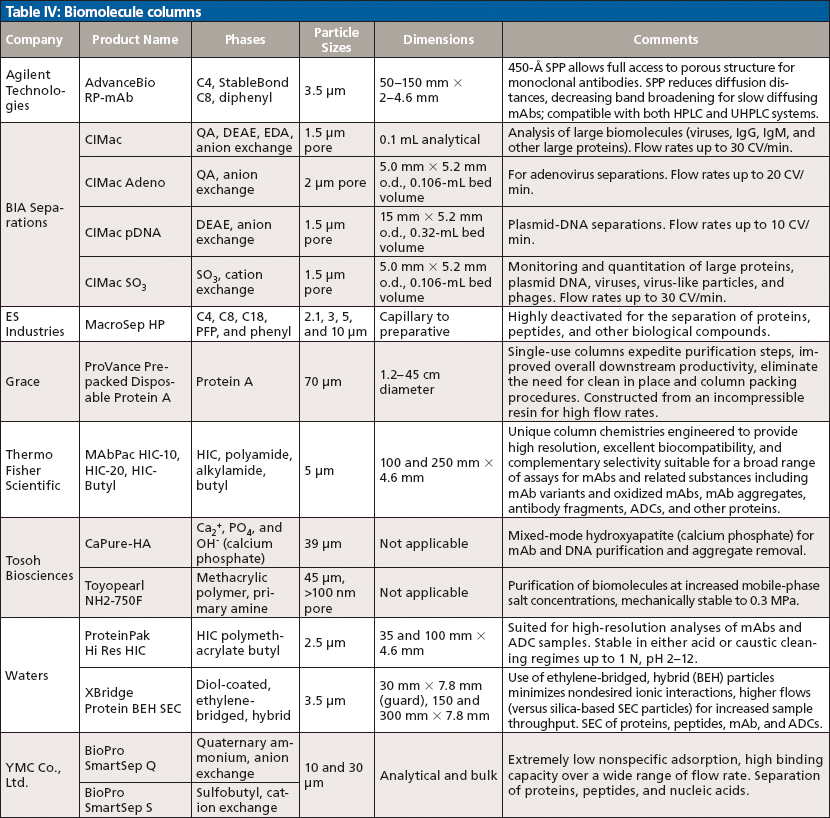
The largest number of new column introductions in the biocolumn category are columns intended for monoclonal antibody (mAb) separations using HIC, reversed-phase, affinity (protein A), or mixed-mode separation mechanisms. Agilent Technologies, Grace, Thermo Fisher Scientific, Tosoh Bioscience, and Waters all introduced HIC columns aimed at mAb separations. Tosoh Bioscience also premiered a mixed-mode hydroxyapatite (calcium phosphate) column for mAb and DNA purification, and aggregate removal, the CaPure-HA. Grace introduced a family of prepacked disposable protein A affinity columns called ProVance. These are single-use columns available in a range of sizes intended for good manufacturing practice (GMP) purification of monoclonal antibodies. Single-use columns can help to expedite purification steps and improve overall downstream productivity, while eliminating the need for tedious clean-in-place and column packing procedures. ProVance columns are constructed from an incompressible resin that ensures performance is maintained at high flow rates, at a cost savings compared to agarose resins.
Agilent Technologies debuted an SPP family of columns named AdvanceBio RP-mAb. Available in three different chemistries, C4, StableBond C8, and diphenyl, AdvanceBio RP-mAb columns are designed specifically for reversed-phase monoclonal antibody separations. The column's 450-Å SPP allows full access to the porous structure for monoclonal antibodies. Like a standard SPP, the AdvanceBio particle technology reduces diffusion distances, resulting in decreased band broadening for slow diffusing mAbs, and is compatible with both HPLC and UHPLC systems.
Thermo Fisher Scientific introduced the MAbPac HIC family of columns consisting of three unique column chemistries: MAbPac HIC-10 (proprietary polyamide), HIC-20 (proprietary alkylamide), and HIC-Butyl for the analysis and characterization of a wide range of mAb samples, including mAb variants and oxidized mAbs, mAb aggregates, antibody fragments, antibody–drug conjugates (ADCs), and other proteins. The HIC-10 and HIC-20 columns are porous (1000-Å pore size) and the HIC-Butyl column is a nonporous hydrophilic polymer-based phase. These unique column chemistries were engineered to provide high resolution, biocompatibility, and complementary selectivity suitable for a broad range of assays for mAbs and related substances.
Waters premiered ProteinPak Hi Res HIC columns for the separation of proteins including mAbs and ADCs. Featuring polymethacrylate base material and a 2.5-µm particle, the ProteinPak Hi Res HIC column is stable in either acid or caustic cleaning regimes up to 1 N, or pH 2–12. Another recent Waters offering is the XBridge Protein BEH SEC column. The XBridge column use of diol-coated, ethylene-bridged hybrid (BEH) particles minimizes undesired ionic interactions and can be operated at higher flows (versus silica-based SEC particles) for increased sample throughput. These columns are quality control (QC) tested with relevant protein and peptide standards, also available for purchase direct from the vendor, for SEC applications of proteins, peptides, mAb, and ADC separations. Figure 2 illustrates an example separation using the XBridge Protein BEH SEC column.
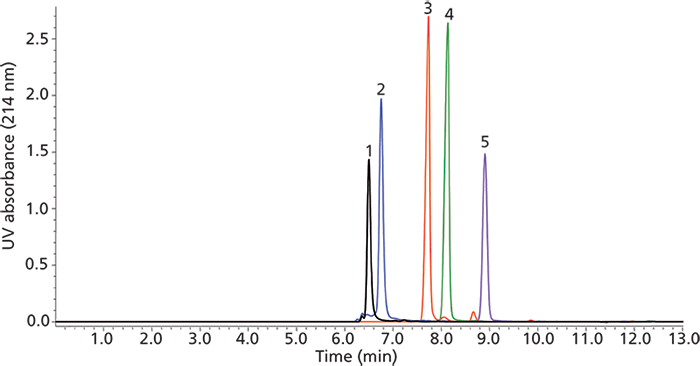
Figure 2: Example separation on a Waters XBridge Protein BEH SEC 125 Å column. Column dimensions: 150 mm × 7.8 mm, 3.5-µm dp; mobile phase: 30% acetonitrile, 0.1% trifluoroacetic acid; temperature: 30 °C; flow rate: 0.84 mL/min. Peaks: 1 = ubiquitin (MW 8565), 2 = aprotinin (MW 6511), 3 = angiotensin (MW 1296), 4 = bradykinin (MW 1060), 5 = Asp-Leu-Trp-Gln-Lys (MW 618). (Figure courtesy of Waters Corporation.)
ES Industries released a pure reversed-phase column targeted toward biomolecules this year. The MacroSep HP line is a family of C4, C8, C18, PFP, and phenyl phases in a variety of common dimensions, from capillary to preparative dimensions. The MacroSep HP columns are highly deactivated for the separation of proteins, peptides, and other biological compounds.
Several ion-exchange phases were introduced for biomolecule separations. BIA Separations introduced three anion-exchange columns and one cation-exchange column. The CIMac, CIMac Adeno, and CIMac pDNA columns are anion-exchange monolith-based columns designed for the analysis of large biomolecules and viruses, adenovirus, and plasmid DNA, respectively. The CIMac SO3 column is a cation-exchange monolith-based column used for the monitoring and quantitation of large proteins, plasmid DNA, viruses, virus-like particles, and phages. The monolith-type medium is a convective interaction medium that is not diffusion limited. All of the BIA columns are available in a variety of configurations, and are billed as high-flow, fast, and reliable process analytical technology (PAT) tools.
Tosoh Bioscience also introduced an anion-exchange column, the Toyopearl NH2-750F. It is a semirigid methacrylic polymer bead phase, stable at pressures as high as 0.3 MPa. Because it is tolerant to increased mobile-phase salt concentrations, it is well suited for aggregate removal, DNA purification, and mAb purification.
YMC introduced a line of ion-exchange columns called BioPro SmartSep Q/S for the separation of proteins, peptides, and nucleic acids. The "Q" is a quaternary ammonium anion-exchange resin, and the "S" is a sulfobutyl cation-exchange resin. The balanced binding capacity and particle rigidness results in high mechanical stability, expanding the usable flow rate range. By optimizing surface modifications, high binding capacity over a wide range of flow rate is obtained, improving throughput for intermediate purification and polishing operations.
Hydrophilic-Interaction Chromatography
Four HILIC columns turned up in this year's survey, all with a diversity of ligands bound to either silica-based totally porous particles (TPPs), or SPPs, in a variety of dimensions. The majority of the HILIC columns featured here are actually for biomolecule separations, but I've broken them out here instead, as summarized in Table V.

Shodex introduced the HILICpak VG-50 4E and 4D columns for reducing sugar and saccharide separations. The tertiary amino phase is usable over a wide pH range of 2–13. Agilent Technologies introduced a wide-ranging family of HILIC columns, on both TPPs and SPPs, in a range of sizes and dimensions. Called AdvanceBio, the columns are aimed at analyzing N-glycans cleaved (in this case) from mAbs to characterize their glycosylation. The AdvanceBio columns can be used in both HPLC and UHPLC modes, offering rapid, high-resolution separations without instrument limitations. The choice of particle size or morphology and column formats allows users to optimize for absolute speed or highest resolution. AdvanceBio columns are QC tested with application-specific glycan samples for more-consistent performance results. Supelco also introduced a line of SPP columns directed at glycan analysis. The BIOshell Glycan columns are intended for glycoprotein analysis, and have a unique stationary phase of a highly polar ligand that possesses five hydroxyl groups tethered to the silica via a novel, proprietary chemical linkage.
Columns for Chiral-Compound Separations
There were three entries in the category of columns for chiral compound separations; all were intended for both HPLC and SFC applications as outlined in Table VI. As a side note, although other SFC columns can be used for chiral compound separations, I've included only columns branded or marketed specifically for chiral compound separations here. For additional SFC introductions, see the section on SFC that appears next.

ColumnTek introduced the Enantiocel-C6 column, a silica-based polysaccharide derivative-coated cellulose tris (phenylcarbamate) phase.
Waters now offers a family of columns specifically for chiral SFC (or what Waters has branded as UPC2) called the Acquity UPC2 Trefoil Columns. Given that chiral compound separations are often referred to as requiring three points of attachment or interaction, the Waters columns are really appropriately named since "trefoil" literally means three-leaved plant. Trefoil columns have a silica-based 2.5-µm particle and are available with three modified polysaccharide-coated chiral phases: amylose tris-(3.5-dimethylphenylcarbamate), cellulose tris-(3,5-dimethylphenylcarbamate), and cellulose tris-(3-chloro-4-methylphenylcarbamate), in 2.1- and 3.0-mm internal diameters, and 50- and 150-mm lengths. Modified polysaccharide-based stationary phases provide broad-spectrum chiral selectivity, and extensive application research of mobile-phase cosolvents and additive blends has demonstrated enhanced chiral recognition for each chiral stationary phase, enabling targeted method development strategies. The Acquity UPC2 Trefoil columns are uniquely designed for the Waters Acquity UPC2 system to enable both selectivity and speed in chiral separations and reduce chiral method development time.
A new column for chiral compound separations, also suitable for use in both HPLC and SFC, the Chiral Art column from YMC is an amylose and cellulose polysaccharide derivative phase offered in a variety of particle sizes and two coated and four immobilized materials. This expanded product range improves the hit ratio on phase screening. Selectivity is guaranteed to be identical across particle sizes, enabling predictable scaling between particles.
Supercritical Fluid Chromatography
Four companies introduced families of SFC columns: AkzoNobel, ES Industries, Microsolv Technology, and Waters (see Table VII).
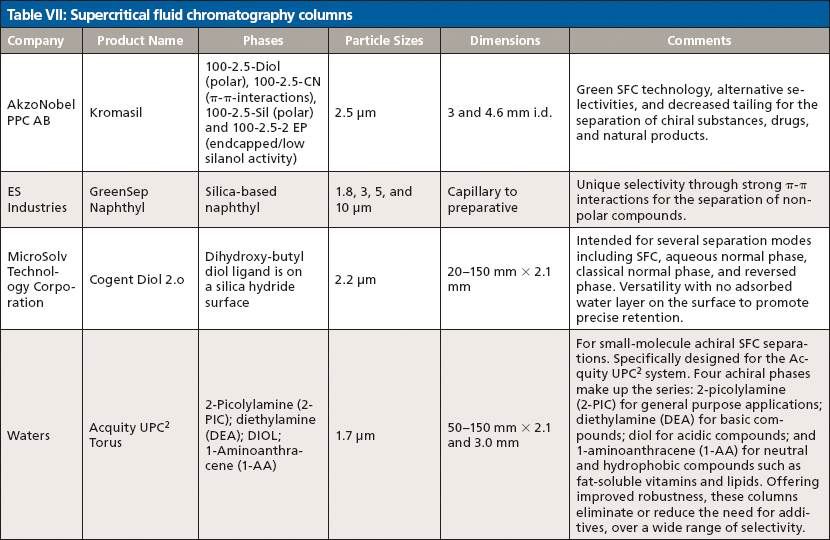
AkzoNobel's Kromasil family of columns for SFC includes four phases: 100-2.5-Diol, 100-2.5-CN, 100-2.5-Sil, and 100-2.5-2EP. Promoting green technology with SFC, the family of 2.5-µm columns provides alternative selectivities and decreased tailing for the separation of chiral substances, drugs, and natural products.
ES Industries checked in with a family of columns for the separation of nonpolar compounds for SFC called GreenSep Naphthyl. This napthyl phase, available in capillary to preparative dimensions and particle sizes of 1.8–10 µm, imparts unique selectivity through strong π-π interactions.
MicroSolv Technology's Cogent Diol 2.o column is intended for several separation modes including SFC, aqueous normal phase, classical normal phase, and reversed phase. Available in a 2.2-µm particle, the dihydroxy-butyl diol ligand is bound to a silica hydride surface, providing versatility with no adsorbed water layer on the surface to promote precise retention.
Waters added to their SFC product line with Acquity UPC2 Torus 1.7-µm columns for small-molecule achiral SFC separations. Like the Trefoil columns, the Torus family is specifically designed for the company's Acquity UPC2 system. Four achiral phases make up the series: 2-picolylamine (2-PIC) for general purpose applications; diethylamine (DEA) for basic compounds; diol for acidic compounds; and 1-aminoanthracene (1-AA) for neutral and hydrophobic compounds such as fat-soluble vitamins and lipids. Offering improved robustness, these columns eliminate or reduce the need for additives, over a wide range of selectivity.
Chromatography Accessories and Devices
Several new products were introduced that fit into the category of either chromatography accessories, new devices, or a combination of both.
Thermo Fisher Scientific premiered the Dionex CRS 500 Chemically Regenerated Suppressor, for ion chromatographs with conductivity detectors. The CRS 500 uses a planar packed bed suppression zone for high peak efficiency and suppression capacity, for improved peak efficiency and better compatibility with columns packed with 4-µm particle size columns.
Two companies introduced fittings specifically for UHPLC applications. The new A-Line Quick Connect fittings from Agilent Technologies are the only truly finger-tight reusable fittings available for UHPLC - no tools are needed. By simply closing a lever, users can reconnect the A-Line Quick Connect fittings multiple times without any loss of performance; the fittings are stable to 1300 bar. For harder to reach areas on any HPLC instrument, the Agilent A-Line Quick Turn fitting produces either a finger-tight connection, stable to 600 bar, or a premium UHPLC connection, stable to 1300 bar with a quick turn of a wrench.
Optimize Technologies' EXP2 line of UHPLC Nano fittings feature titanium hybrid Ti-Lok ferrules for 1/16-in. and 1/32-in. PEEKsil tubing. The EXP2 male fittings feature a 3/16-in. hex head with a removable slotted knurled wrench for hand tightening to over 20,000 psi, depending on the tubing internal diameter. EXP2 Ti-Lok Kits are available with EXP2 nuts, Ti-Lok ferrules, and PEEKsil tubing. The 3/16-in. hex-head nuts fit tight spaces such as sample injection valves or loops, column connections, and column ovens.
In what is a unique combination of accessory or device and column, the Waters iKey Separation Device is one of the enabling technologies of the Waters ionKey/MS system, delivers increased sensitivity for sample-limited applications, and combines the advantages of microflow LC with a greatly simplified device. The innovative iKey eliminates the need for traditional fittings and greatly simplifies the microflow-LC user experience. Chromatographers turn to microscale LC when looking for higher sensitivity and lower limits of detection. However, this technique presents unique challenges such as the need for specialized equipment along with having to pay close attention to tubing connections and capillary lengths. The true plug-and-play design of the iKey eliminates these connection and variability challenges. The iKey Separation Device contains the fluidic channel, electronics, electrospray ionization interface, column heater, eCord, and column chemistry for performing UHPLC separations directly in the source of Waters mass spectrometers. The internal column is a high-strength silica-based 1.8-µm C18 TPP available in either 50 mm × 150 µm or 100 mm × 150 µm column dimensions. The high-strength silica phase enables separations at UHPLC pressures, with applications that include high retentivity for polar organic compounds and metabolites and a balanced retention for hydrophobic analytes.
Acknowledgment
I would like to thank the manufacturers and distributors that responded to the LCGC survey for inclusion in this review. Although I (and others at LCGC) have made every attempt to include all new chromatography column and related products introduced during the past year, I'm sure that this review is not exhaustive so I apologize in advance for any products that were omitted. However, if you did miss out, and would like to be included next year, please contact Laura Bush, Editorial Director, LCGC North America, lbush@advanstar.com, with the subject line "2016 Column Review."
References
(1) M.W. Dong, LCGC North Am.33(4), 254–261 (2015).
(2) J.V. Hinshaw, LCGC North Am.33(5), in press (2015).
(3) D.E. Raynie, LCGC North Am.33(5), in press (2015).
This month's guest author:
Michael Swartz is with Boston Analytical in Salem, New Hampshire and is a member of LCGC's editorial advisory board. Swartz was also a column editor for LCGC's "Innovations in HPLC" and "Validation Viewpoints" columns.

Michael Swartz
Editor of Column Watch:
Ronald E. Majors is the editor of "Column Watch," an analytical consultant, and a member of LCGC's editorial advisory board. Direct correspondence about this column to lcgcedit@lcgcmag.com

Ronald E. Majors
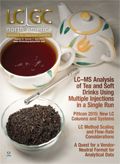
Common Challenges in Nitrosamine Analysis: An LCGC International Peer Exchange
April 15th 2025A recent roundtable discussion featuring Aloka Srinivasan of Raaha, Mayank Bhanti of the United States Pharmacopeia (USP), and Amber Burch of Purisys discussed the challenges surrounding nitrosamine analysis in pharmaceuticals.
Extracting Estrogenic Hormones Using Rotating Disk and Modified Clays
April 14th 2025University of Caldas and University of Chile researchers extracted estrogenic hormones from wastewater samples using rotating disk sorption extraction. After extraction, the concentrated analytes were measured using liquid chromatography coupled with photodiode array detection (HPLC-PDA).














